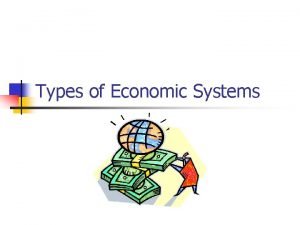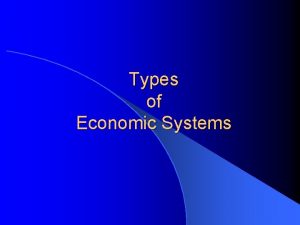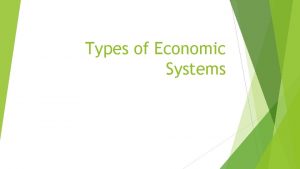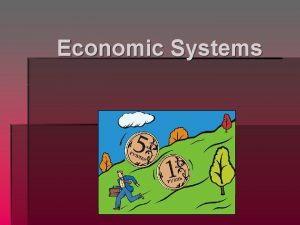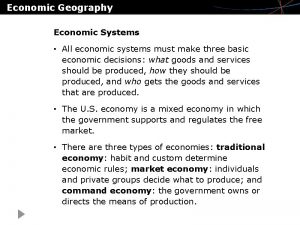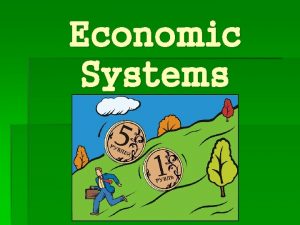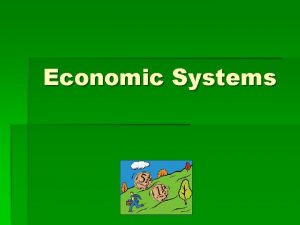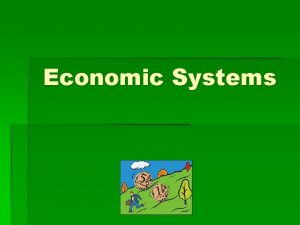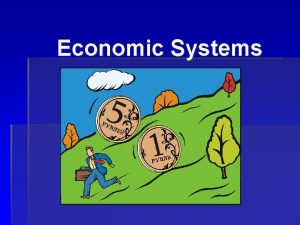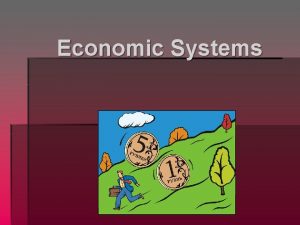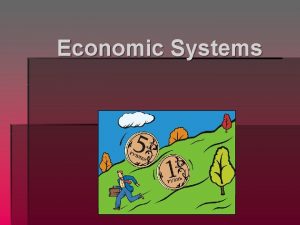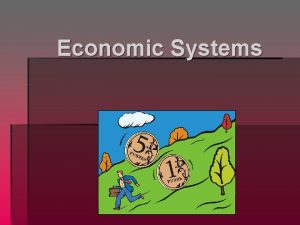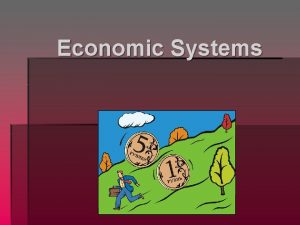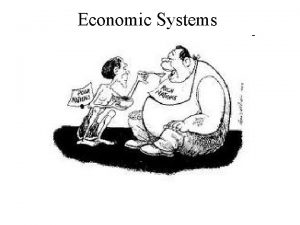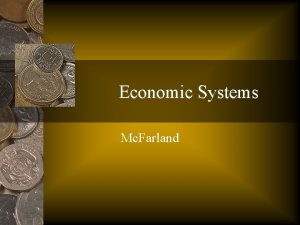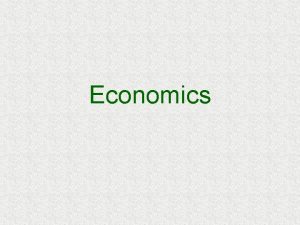TYPES OF ECONOMIC SYSTEMS Types of Systems The























- Slides: 23

TYPES OF ECONOMIC SYSTEMS

Types of Systems The question that each economy faces is whether they want prices, quantities, distribution of goods and services, and distribution of income to be determined by the private sector or the public sector. Private sector – made up of consumers and businesses. Public sector is the government. There are different levels of government : local, state and federal. Some services are produced by both private and public agencies such as education, trash collection, and security. The groups in the economy are consumers, businesses, and government.

An Economic System designed around consumers and Players Goal businesses. Examples Consumers Maximize personal utility Some people maximize their utility (happiness) by purchasing material goods. Some people maximize their utility by giving away their time and money to charity/ missions. http: //www. youtube. com/watch? v=90 Hh. Zpy. C 2 Y Businesses Maximize long-run profit Businesses maximize profit to make owners happy! http: //news. exxonmobil. com/press-release/exxonmobil-corporation-announces-estimated-secondquarter-2013 -results Government Maximize social welfare http: //www. edd. cahwnet. gov/Unemployment/F ederal_Unemployment_Insurance. Extensions. htm

Types of Economies • Command - governments determines prices and quantities produced • Capitalistic • free market interaction between buyers and sells determines prices and quantities produced Mixed a mix where in some markets the government is a buyer, regulator, or producer. Even with a free market capitalist system there are times when the system does not operate in a manner that best suits the overall population. These occurrences are known as free market breakdowns. Some of these free market breakdowns are on the “Free Market Breakdown” page on the website.

Principles of Capitalism addresses the needs of consumers and businesses. Capitalism attempts to solve problems without government intervention. Capitalism inspires free enterprise. Capitalism promotes private property rights.

Five Questions each economy must address How a country answers these questions reveals the type of economic system that will prevail. A capitalistic country looks to the private sector to address these questions.

Question: 1 It How much should the economy produce? depends on the resources it has available The resources are land, labor, capital and entrepreneurial spirit. The goal is to use each of the resources efficiently.

US Farmland 1997, 2002 and 2007 Census of Agriculture Approximate total land area (acres) Total farmland (acres) 1997 2002 2007 2, 262, 462, 020 2, 263, 960, 501 2, 260, 994, 361 954, 752, 502 938, 279, 056 922, 095, 840 http: //news. exxonmobil. com/press. Percent of total land release/exxon-mobil-corporation 42. 2% 41. 4% area announces-estimated-second-quarter-2013 Cropland (acres) 434, 164, 946 -results 445, 324, 765 • 40. 8% 406, 424, 909 Percent of total farmland 46. 6% 46. 3% 44. 1% Percent irrigated 11. 5% 11. 6% 12. 7% On the arable land, which is only 11% of Japan's total land area, the population density is among the highest in the world. • 145, 833 sq mi in Japan – 15, 000 square miles of farmable land • 9, 600, 000 square acres • Census of Agriculture • Contact NASS Customer Service, 1 -800 -727 -9540.

2. What should be produced?

3. How are the goods and services produced? By the most efficient companies. Top Ten Most Profitable Companies Sometimes by the government. In a capitalistic system the best companies survive, the weaker companies go out of business. 1 Royal Dutch Shell oil 3 Exxon Mobil oil 5 China National Petroleum oil 7 State Grid oil 9 Volkswagen 2 Wal-Mart Stores 4 Sinopec Group oil 6 BP oil 8 Toyota Motor 10 Total oil

4. Who receives the output? Income Distribution by Quintile YEAR BOT 20 MID 20 TOP 5 2010 116, 011 3. 9 8. 8 13. 9 20. 2 53. 5 2005 114, 384 3. 4 8. 6 14. 6 23 50. 4 22. 2 2000 108, 209 3. 6 8. 9 14. 8 23 49. 8 22. 1 1990 94, 312 3. 8 9. 6 15. 9 24 46. 6 18. 5 1970 64, 778 4. 1 10. 8 17. 4 24. 5 43. 3 16. 6

The Distribution of Income is not equal in the United States. In the US the top 20 percent of wages earners make 53 percent of the income. The bottom 20 percent of the wage earners make 3. 9 percent of the money. In a Communist Society, theoretically every one would make the same amount. Their would be no rich or poor. Yet, there would also be no incentive to work hard because everyone makes the same amount.

Percent of Taxes Paid by Quintile

5. Can the system adapt to change? Country Agriculture Industry Service United States 0. 9% 20. 4% 78. 6% South Korea 3. 3% 40. 7% 56% 13. 1 % 46% 41% Indonesia

Employment by Sector Occupations 1900 2010 number percent Agriculture 10. 4 35. 7% 4. 3 2. 9% Manufacturing 7. 1 24. 4% 11. 5 7. 8% Trade and Transportation 4. 8 16. 5% 24. 9 16. 8% Services 6. 8 23. 4% 107. 3 72. 5% Total 29. 1 In millions 148

These were so cool!

State of the Art


Change does occur in the US without government intervention. Businesses change to earn profit. Cell phones have gotten smaller, batteries last longer, service has improved. Why? Because companies want to earn profit, and these qualities attract consumers! Music is now played on a Smart Phone, MP 3 or I-Touch. Why? Because companies want to earn profit and these smaller units attract consumers.

The U. S. Economy is mixed. Some goods and services are produced by private companies. Some goods and services are produced by the government. The trend in the US is for more government. There are pros and cons of more government. The biggest cons are incentive to work and large deficits. The pros are stability and equality among citizens.

How can the type of economic system be determined? Government percent of overall spending http: //anepigone. blogspot. com/2008/ 03/government-spending-aspercentage-of. html http: //www. usgovernmentspending. c om http: //www. heritage. org/index/Rankin g. aspx

Property Rights are important in Capitalism Tragedy of the Commons Ownership is necessary, otherwise no one will value the property. The Family Pond – passed down to the

Why has the government sector grown so much? Free Market Breakdowns?
 Economics unit 1 lesson 2 difficult choices
Economics unit 1 lesson 2 difficult choices Command economy
Command economy Command economy
Command economy Economic growth vs economic development
Economic growth vs economic development Economic development vs economic growth
Economic development vs economic growth Hát kết hợp bộ gõ cơ thể
Hát kết hợp bộ gõ cơ thể Slidetodoc
Slidetodoc Bổ thể
Bổ thể Tỉ lệ cơ thể trẻ em
Tỉ lệ cơ thể trẻ em Gấu đi như thế nào
Gấu đi như thế nào Glasgow thang điểm
Glasgow thang điểm Alleluia hat len nguoi oi
Alleluia hat len nguoi oi Các môn thể thao bắt đầu bằng tiếng chạy
Các môn thể thao bắt đầu bằng tiếng chạy Thế nào là hệ số cao nhất
Thế nào là hệ số cao nhất Các châu lục và đại dương trên thế giới
Các châu lục và đại dương trên thế giới Cong thức tính động năng
Cong thức tính động năng Trời xanh đây là của chúng ta thể thơ
Trời xanh đây là của chúng ta thể thơ Mật thư tọa độ 5x5
Mật thư tọa độ 5x5 Phép trừ bù
Phép trừ bù Phản ứng thế ankan
Phản ứng thế ankan Các châu lục và đại dương trên thế giới
Các châu lục và đại dương trên thế giới Thơ thất ngôn tứ tuyệt đường luật
Thơ thất ngôn tứ tuyệt đường luật Quá trình desamine hóa có thể tạo ra
Quá trình desamine hóa có thể tạo ra Một số thể thơ truyền thống
Một số thể thơ truyền thống

